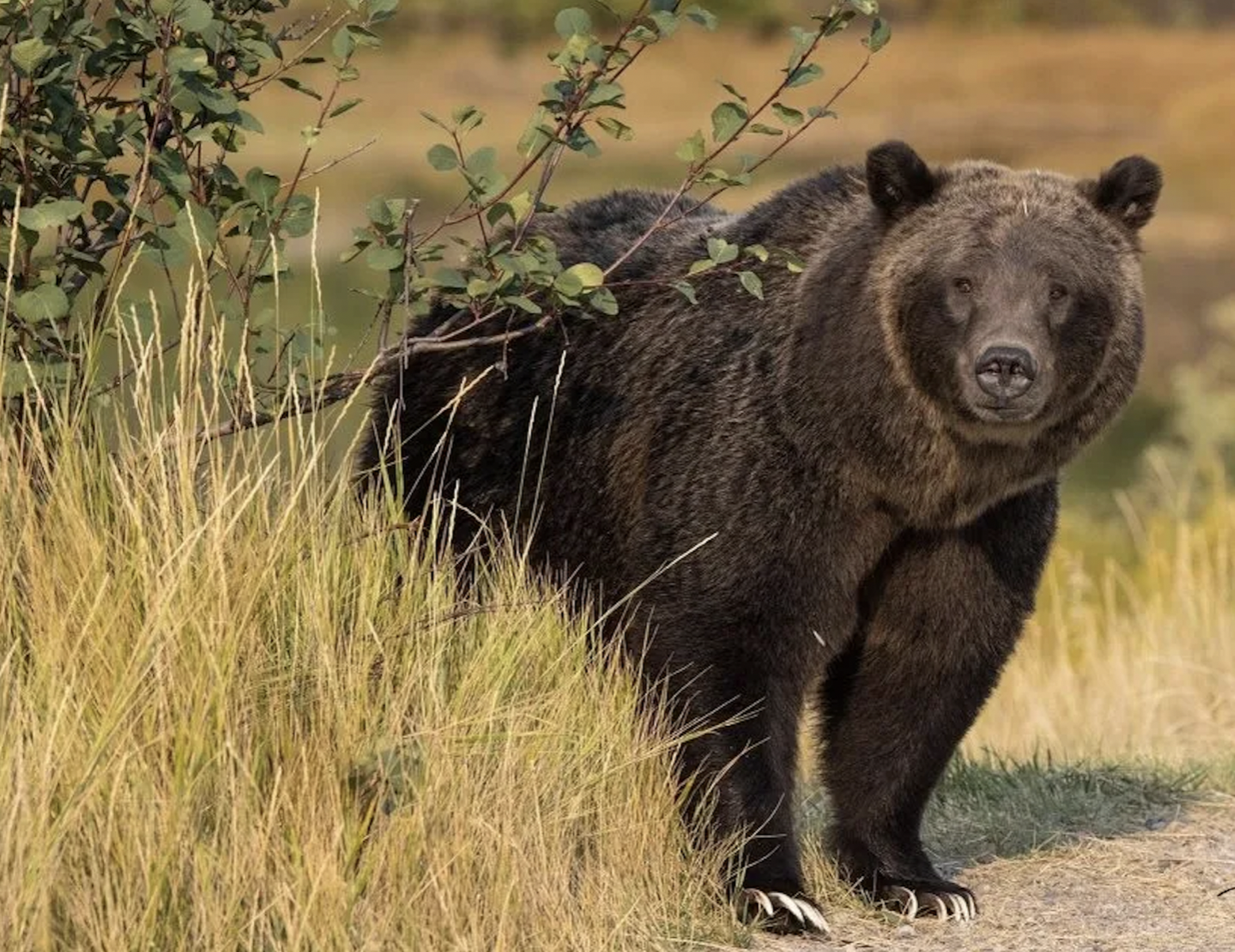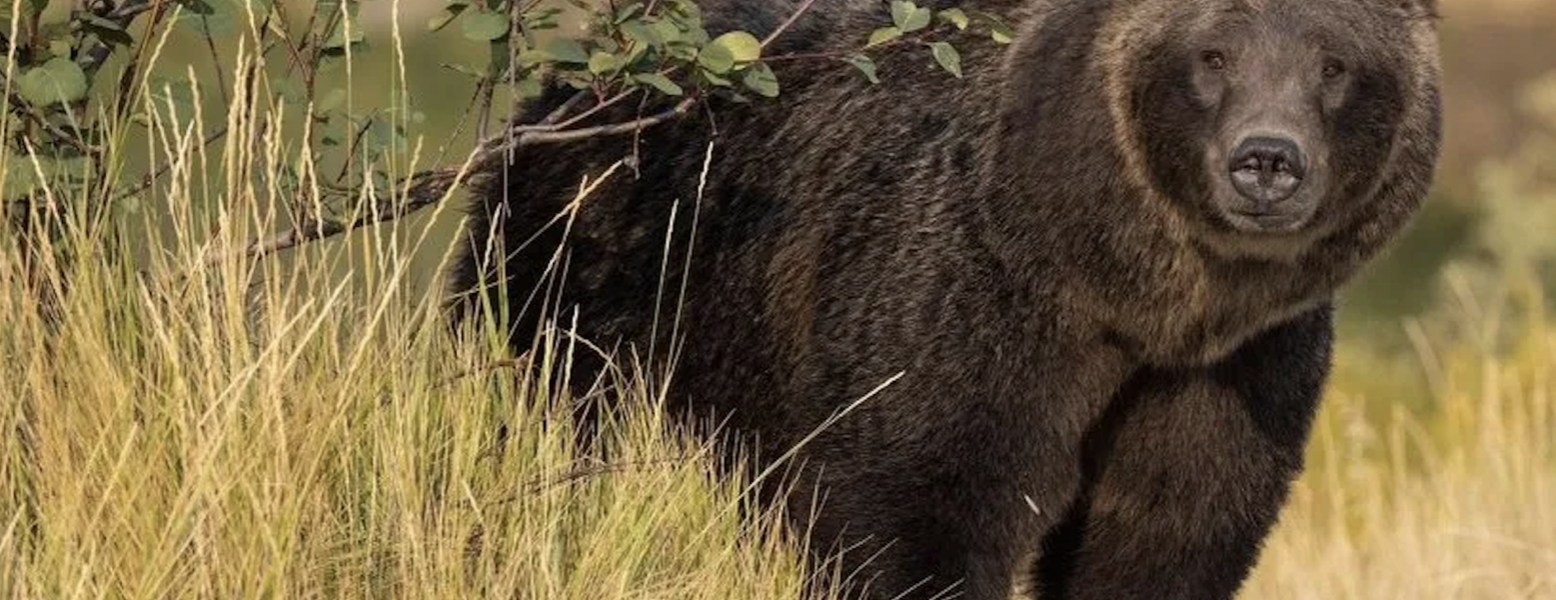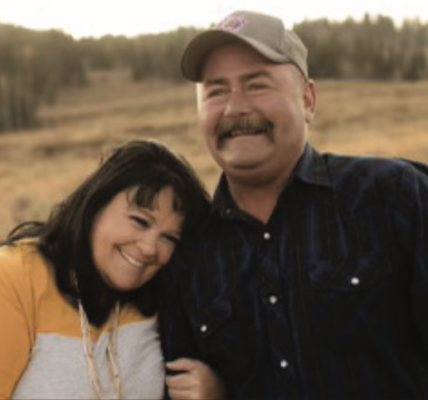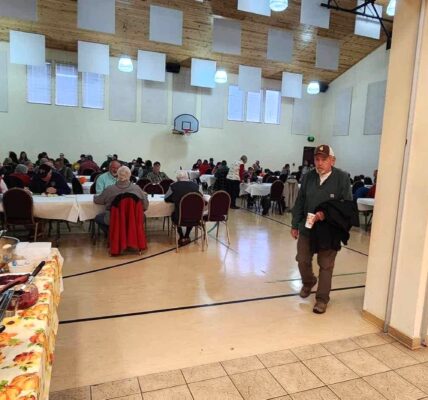Grizzly 399 has hopped Grand Teton’s southern border — and crossed onto private land

• Famous bruin, cub spotted on private land; wildlife managers urge caution with trash, food
By Billy Arnold
Jackson Hole News&Guide
Via- Wyoming News Exchange
JACKSON — Brian McCooey thought it odd.
Before he put his eyes on the traffic, he saw it on his GPS app: a cluster of red around the Gros Ventre River bridge, but nowhere else on Highway 89/191 between him and downtown Jackson. He assumed people had stopped to gawk at moose or a herd of elk. But he also decided to stop, and walked out onto the bridge.
“I lucked out,” McCooey said. “She was walking across the river with the cub.”
She, in this case, was Grizzly 399, the famous ursine matriarch that has raised litter after litter of cubs by the roads in Grand Teton National Park. Earlier this year the 27-year-old bear became the oldest known grizzly mother when she emerged from a den with the single cub she now has in tow.
Yet since 2020, when 399 had four cubs, the grizzly has begun ditching the national park’s roadsides and forests and venturing south into suburban Jackson, where there are more people, more human-related foods to eat — and possibly more danger for bears.
She made her first southern sojourn of the season Friday, leaving Teton park and following the fence along the western edge of the National Elk Refuge. After standing up to investigate the fence and shaking a couple of gates, 399 found a way to cross back into the park and then split west toward private land.
McCooey said the crowd was huge when he got there: park rangers and about 100 onlookers. It was roughly 5:30 p.m., “and the volume of people just kept growing,” he said.
National Park Service officials said bear managers last spotted 399 on Saturday, south of the park.
In past travels, 399 has gotten into trash, livestock feed and beehives, and even gotten her own federal escort, which is highly unusual for a bear. Her jaunt through town in 2021, caught on video outside Jackson’s Town Hall, spurred town and county officials to pass new regulations requiring bear-resistant trash cans and a general lockdown of all bear attractants.
Where 399 has traveled since Friday isn’t the sort of information managers and bear watchers publicize, hoping to dissuade hordes of people from assailing the famous bruin as she moves around the valley.
But Chris Colligan, a county official who has spent the last year spearheading the bear-proofing efforts, said 399’s southerly trajectory is an important reminder of how closely Teton County residents live with bears, particularly in the fall when bears feed voraciously to bulk up for hibernation.
“This is the time of year that bears become active, not just 399,” Colligan said. “It’s just a good reminder to be extra vigilant in the fall and when you’re out recreating. Be aware of your surroundings.”
Residents and visitors should use a bear-resistant trash can, keep trash cans that aren’t bear-resistant behind closed doors when possible, hang bird feeders out of bears’ reach, and lock up other attractants such as beehives, compost bins and livestock feed. Bear Wise Jackson Hole posts information about all of that, as well as regulations, at JHWildlife.org/bearwise-jh/. Most trash haulers have bear-resistant trash cans, and Jackson Hole Bear Solutions has been providing cans at a discount. Bear Wise and the Wyoming Game and Fish Department also help residents guard compost, livestock feed and other attractants with electric fencing.
This year, Colligan said Teton County is much more bear proof than it has been. But there are still chinks in the armor built to protect residents and bears. When bears get into human foods, like trash, beehives or bird feeders, they can get used to accessing it — and aggressive in trying to do so. Once bears become habituated, managers often remove or kill them to prevent human injury.
Homeowners, renters and businesses are required to use bear-resistant trash cans in all of Teton County and some areas on the periphery of the town of Jackson. In the county, compliance has been relatively high.
County officials and Kole Stewart, program manager for Bear Wise Jackson Hole, have surveyed neighborhoods on trash day to figure out how many people have bear-resistant cans. They’ve put about 500 notices on noncompliant cans but haven’t taken formal enforcement action against anyone yet, Colligan said.
In northern neighborhoods such as Jackson Hole Golf and Tennis and the Solitude subdivision, where a resident fed 399 and her four cubs in 2021, compliance is high — more than 99%, Colligan said. On the West Bank, that number is closer to 97%. Both areas have been required to have bear-resistant cans for more than a decade.
“That actually made me feel really proud to be part of the community, to see that level of compliance,” Colligan said. “That doesn’t mean that we don’t have work to do.”
In neighborhoods where the regulation is newer — Rafter J, Game Creek, Hoback and Hog Island — Colligan said compliance is lower, hovering between 75% and 78%.
There are also still a number of unsecured commercial dumpsters, Colligan said, and potential for a litany of other food rewards: coolers on people’s porches, fruit trees, dirty grills.
“We need to be extra vigilant, particularly in the fall when bears are starting to roam,” Colligan said.
In 2021, when 399’s behavior took a concerning turn — she and the four cubs started accessing human-related foods with greater frequency — officials with Wyoming Game and Fish and U.S. Fish and Wildlife Service tailed her and her brood 24/7, attempting to shoo her away from those rewards.
This year, Dan Thompson, Game and Fish’s large carnivore supervisor, said the situation has been calm.
“We have no evidence of conflicts involving 399 based on any recent travels,” Thompson said.
Game and Fish also hasn’t hazed 399 and her cub yet, and Thompson hopes officials won’t have to: “We will respond to situations as we always do and deal with any conflicts as we need to.”
Hilary Cooley, the Fish and Wildlife Service’s grizzly bear recovery coordinator, was not able to comment before press time. While grizzly bears are listed as “threatened” under the Endangered Species Act, and the feds have to approve a state’s relocating or a killing of a bear, Game and Fish is the primary agency that manages bears when on private land.
The Fish and Wildlife Service has, however, hired a staffer to help deal with bear conflicts in Jackson Hole, working with bears like 399 and other grizzlies in the area.





